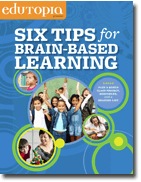This free, 13-page resource guide by Edutopia offers practical tips for putting brain-based learning into action in K-12 classrooms, along with supporting resources including reading lists, videos, and published articles.
Overview
This resource guide covers 6 topics:
- Creating a safe climate for learning
- Encouraging a growth mindset
- Emphasizing feedback
- Getting bodies and brains in gear
- Starting early
- Embracing the power of novelty
The downloadable PDF also includes a project, suited to high school-aged students, which asks students to build a “Brain Owner’s Manual.” Since the guide aims to reach K-12 educators, some of the examples and links have elementary school classrooms in mind, but there’s plenty for high school teachers who want to build their knowledge and skills in relation to brain-based learning.
Potential Use
Professional Development – self-guided and classroom activities.
This guide can be explored for individual professional growth. It also provides ideas for projects that can be completed with students k-12 in the classroom.
Good to know: a Road Map to this Resource

The time it takes to complete the resource guide will be determined by the number of additional resources viewed, but set aside an hour or two for an in-depth review.

Sign in or registration is required on Edutopia to download this resource. A “sign in” option includes logging it with an existing Facebook, Twitter, Yahoo, or Google account.

The guide itself is easy to follow. Each of the six “tips” is introduced on one or two pages with embedded links to related articles and videos as well as examples of the tip in action by other educators from blogs and videos. Each “tip” page also includes a “Learn More” section on the right hand side with even more resources. The “Bonus Project” section provides advice on developing grade specific activity to help students build a “Brain Owners Manual”. Several resources for students are included. The last page provides a list of related books in “Recommended Reading”.

- Access the guide from the main Edutopia website through the Classroom Guides section in the main menu.

The following resources are related to the guide and listed below the guide’s description on the main site:
Neuro Myths: Separating Fact and Fiction in Brain-Based Learning: This short article provides tips to help determine which tools and resources are really based on sound science.
Brain-Based Learning: Resource Roundup: This resource is linked within the guide and provides an extensive list of all the Edutopia resources related to learning and the brain as well as links to online resources from other organizations.
Big Thinker: Neurologist Judy Willis on the Science of Learning: This video runs about 12 minutes. It explores the science behind boredom and how to get kids interested, as well as lessons in how kids learn for the 21st century.

Brain-based Learning Blog: Access the blog from by clicking on the Blogs header and selecting the brain-based learning topic from the pull down menu. Recent post topics include “Engaging Brains: How to Enhance Learning by Teaching Kids About Neuroplasticity”.
Follow Edutopia: Follow Edutopia on twitter @edutopia or sign up for their newsletter when you register.
How does this align with student-centered learning research and practice?
The most important findings from the current neuroscience research, which aligns with our Mind, Brain, and Education research synthesis, are embedded throughout the guide, and like the Students at the Center research, offers caveats about applying the research too broadly. It also connects to the Students at the Center Framework, supporting all of the four tenets.
Source Organization: Edutopia
